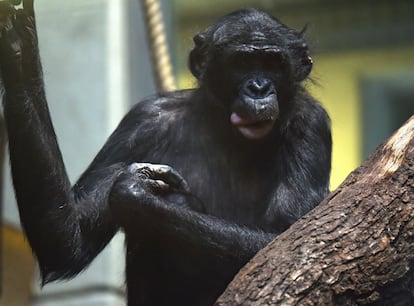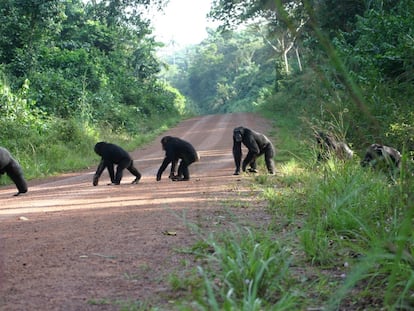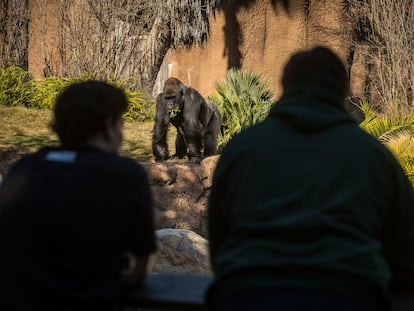Bonobos can be equally or more violent than chimpanzees
Thousands of hours of observation of communities of both species debunk the former’s peaceful image: males are three times more aggressive than the latter

For decades, there has been a dichotomous image of the two primate species closest to humans: chimpanzees (Pan troglodytes) are very aggressive, and violence forms the basis of their social relationships, while bonobos (Pan paniscus) are the peaceful cousins who settle almost all their disagreements with sex and caresses. However, the observation of several communities of both species over thousands of hours shows that things are more complex: male bonobos go as far as tripling the aggressions made by chimpanzees when the aggressor is another male.
“I remember at the beginning of my first field season, we were in the jungle and the bonobos had just woken up, it was still quiet when I heard screaming and crying. I saw two furballs running through the trees, one bonobo chasing another. It was such an early morning aggression. I saw another one about 10 to 15 minutes later. It raised a lot of questions for me about bonobos’ use of violence,” Boston University researcher Maud Mouginot recalls of her four-month stay in the Kokolopori Bonobo Reserve (Democratic Republic of Congo) in 2019, which followed another stint the previous year in Gombe National Park, home to several chimpanzee communities. Those two periods observing the two species formed the basis for a research project that now, five years later, just published its results in Current Biology.
During 2,047 hours of observation of three bonobo communities in Kokolopori, Mouginot and her research colleagues counted 521 aggressions. Most were simple shoves and chases. But in 14.8% of the cases there was physical harm. Meanwhile, in the 7,309 hours of watching two groups of chimpanzees at Gombe, they counted 654 aggressive interactions, 15.1% involving contact. “I was surprised by the results! Bonobos have a reputation for being peaceful, but I always thought that was too simplistic a way of looking at such a complex species,” says Mouginot. It is one of the keys to this work, which quantifies and classifies different types of violence.
When we go into detail, we move from scenarios where everything was black and white to other situations full of gray. Although in general the aggressions of bonobos are less serious (and there is not a single lethal case described in the scientific literature), among the males of this species there are 2.8 more attacks than among chimpanzee males and attacks triple when there is physical damage. “I did not expect to find such aggression rates among males,” stresses Mouginot. Only 16% of the attacks involved aggression towards a female, a percentage almost identical to those observed in the opposite direction, from a female to a male. Everything changes with chimpanzees.
“Male-female dynamics are very different between the two species. In bonobos, females are co-dominant with respect to males and can form coalitions against them. Therefore, females can act aggressively against males alone or in a coalition, and male bonobos rarely act aggressively against females.” The situation is radically different among Pan troglodytes. “Among chimpanzees, males form coalitions and outrank all females. [Males] sexually force [females] to mate with them and thus act aggressively against them. These social dynamics change male-female interactions and rates of aggression between the sexes.” Specifically, up to 32% of male attacks are directed at a female, while the opposite situation was observed only 1.8% of the time.
Mouginot describes one of the keys about coalitions. Almost non-existent among male bonobos, it is common practice among chimpanzees, both to attack or defend themselves within their own community, and to unleash real wars against other groups in which they actively seek to kill rivals. The other key is mating. The females of both species have periodic swelling in their genitalia, indicating that they are ovulating. In chimpanzees, researchers found that the more aggressive chimpanzees copulated more with the more tumescent females. While researchers also saw this relationship among bonobos, the statistical significance was much smaller.
Male aggression against females is much lower in bonobos and does not appear to be used in the context of matingPrimatologist Martin Surbeck of Harvard University’s Pan Lab
Martin Surbeck was director of the Kokolopori bonobo reserve and is the principal investigator at Harvard University’s Pan Lab. He notes some differences in the violence of the two species confirmed by this new study: “First, there have been no reported cases of lethal aggression between bonobos, either within or between groups. It is possible that some bonobos die as a result of injuries, but we do not see aggression aimed at killing the opponent, as has been described in the case of chimpanzees.” The other major difference has to do with sexual fitness. “In bonobos, there is much less aggression by males against females, and they don’t seem to use it in the context of mating. So, there’s still the absence of sexual violence, which makes it even more interesting,” he adds.
Surbeck says that “it seems clear that male aggression rates are at least equally as high in bonobos (in this study they were higher, but we have to see if this difference holds including other populations). He concludes that “they definitely no longer fit what the stereotypes previously portrayed.”
Primatologist Josep Call, of the University of St. Andrews in the United Kingdom, emphasizes that “the dichotomy between aggressive chimpanzees and peaceful bonobos is a fallacy.” He adds that that was something that “experts have known for many years, but even so, there are some who like to continue with this false dichotomy, which de Waal initiated many years ago.” For Call, one must take into account that “both chimpanzees and bonobos are aggressive; what happens is that their styles and their targets are different.” But the researcher also reminds us that neither species is only aggressive. “Of course, both are also peaceful and reconcile after fighting, for example. But, again, their styles are different; for example, bonobos use more socio-sexual behaviors than chimpanzees.” According to Call, the study’s main limitation is one that Surbeck also mentioned: it only compares Gombe chimpanzees and Kokolopori bonobos. “I would have liked to see data from other places because there are big differences between populations.” Had the research done that, Call is convinced that “it would have highlighted the variability within and between populations and species.”
Mouginot, the lead author of this study, offers a final thought. Many primatologists, including herself as she acknowledges, have investigated violence among these animals to seek answers as to why human-to-human violence occurs, placing chimpanzees on one side and bonobos on the other. “Researchers often refer to chimpanzees, or sometimes bonobos, as the best model of our last common ancestor. I don’t think any of those species is a good model; they all followed their own evolutionary path. What is interesting is observing how some strategies evolve in some species and not in others.”
Sign up for our weekly newsletter to get more English-language news coverage from EL PAÍS USA Edition
Tu suscripción se está usando en otro dispositivo
¿Quieres añadir otro usuario a tu suscripción?
Si continúas leyendo en este dispositivo, no se podrá leer en el otro.
FlechaTu suscripción se está usando en otro dispositivo y solo puedes acceder a EL PAÍS desde un dispositivo a la vez.
Si quieres compartir tu cuenta, cambia tu suscripción a la modalidad Premium, así podrás añadir otro usuario. Cada uno accederá con su propia cuenta de email, lo que os permitirá personalizar vuestra experiencia en EL PAÍS.
¿Tienes una suscripción de empresa? Accede aquí para contratar más cuentas.
En el caso de no saber quién está usando tu cuenta, te recomendamos cambiar tu contraseña aquí.
Si decides continuar compartiendo tu cuenta, este mensaje se mostrará en tu dispositivo y en el de la otra persona que está usando tu cuenta de forma indefinida, afectando a tu experiencia de lectura. Puedes consultar aquí los términos y condiciones de la suscripción digital.











































